Database Reference
In-Depth Information
T
ABLE
23-2
Out Of Memory Error Scenarios
Scalability of Applications Based on the Java Stack
SAP applications based on the Java stack are highly scalable, and there are several ways to
scale them. The following sections will list and discuss the different ways to scale the Java
application. Scaling is important for provisioning, as it enables the system to handle in-
creased concurrent user access or increased load.
Server Node
Server nodes in the Java stack are comparable to the work processes in the ABAP stack,
with few differences. Unlike ABAP work processes, Java server nodes are multithreaded
and are therefore capable of multitasking. ABAP work processes are single-threaded and
perform one task at a time. The multithreaded server node architecture of the Java stack will
allow few server nodes to process the load coming to the Java stack from the end users. Be-
cause of this key difference, there are far fewer Java server nodes compared to ABAP work
processes. The number of server nodes to be configured will depend on the availability of
the physical memory and CPU resources of the hardware. The addition of more server nodes
will improve system performance as long as adequate resources are available at the operat-
ing system level. The configuration tool is used to add more server nodes. Select the in-
stance to which a new node has to be added and choose Server | Add Server.
Application and System Threads
The server nodes are multithreaded, and the number of threads can be increased based on
the workload and availability of system resources. Application and system threads are the
most important ones that need to be configured to improve the system performance. Applic-

